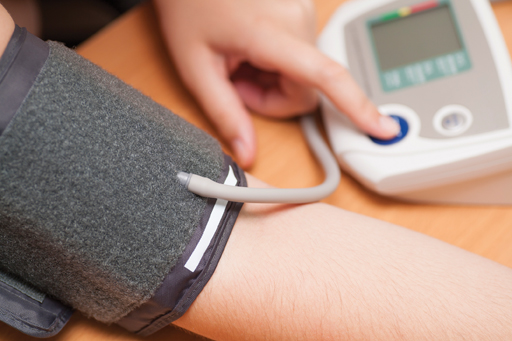Clinical review: Antihypertensive medications
In Clinical
Follow this topic
Bookmark
Record learning outcomes
In our CPD module on managing blood pressure we consider the screening and management of hypertension. Here we look in greater detail at the different classes of antihypertensives.

Angiotensin-converting enzyme (ACE) inhibitors
The choice of ACE inhibitor depends on existing co-morbidities. For example, enalapril, lisinopril, perindopril, ramipril or trandolapril may be the preferred choice as a once-a-day formulation for patients with diabetes and hypertension.
Angioedema is one of the contraindications to using this class of medicine, as are pregnancy and breastfeeding. In renal impairment, hyperkalaemia and other adverse effects are more common, and the dose may need to be reduced. Caution must be exercised in those taking diuretics due to potential hyperkalaemia and the increased likelihood of ‘first dose’ hypotension.
Cough occurs in about 15 per cent of people taking an ACE inhibitor and may occur at any time after starting treatment. Where it is affecting an individual’s lifestyle, an ARB could be considered.
On initiation, a low dose must be used with gradual upward titration (usually every two to four weeks depending on the drug) until the target blood pressure has been achieved or a tolerated dose of ACE inhibitor has been reached.
Renal function and serum electrolytes must be checked prior to starting treatment, after dose increases, at stabilisation and annually (or more frequently if required) as renal impairment and hyperkalaemia are common adverse effects.
Angiotensin-II receptor blockers (ARB)
ARBs cause less cough and angioedema than ACE inhibitors, so are more likely to be tolerated. The choice varies depending on co-morbidities, with people with heart failure and hypertension being prescribed candesartan, losartan and valsartan, and those with diabetes and hypertension prescribed candesartan, irbesartan, losartan or valsartan.
Diabetes, pregnancy and breastfeeding are all contraindications of ARBs and caution must be used in people of black African or Caribbean origin as they may respond less well to ARBs. In renal impairment, hyperkalaemia and other adverse effects are more common, and the dose may need to be reduced and renal function monitored.
Concomitant use of ACE inhibitors and ARBs affecting the renin-angiotensin system increases the risk of hypotension and renal impairment, which should be avoided. NSAIDs should be also taken with caution when taking ARBs due to the reduction of the antihypertensive effect and the worsening of renal function, especially in the elderly.
On initiation, titration is required with low doses of ARBs. Patients taking high-dose diuretics (equivalent to 80mg furosemide or more) need to initiate ARB treatment in secondary care. It is essential to monitor renal function throughout titration and at least annually.
Thiazide-type diuretics
Chlortalidone and indapamide, which are taken in the morning, are the preferred choice of thiazide-type diuretic. Conventional thiazide diuretics such as bendroflumethiazide are still used where the patient has been established on this medicine and their blood pressure is well controlled.
Thiazide-type diuretics should be avoided in some patients including those with refractory hypokalaemia, hyponatraemia and hypercalcaemia. They are used with caution in people with diabetes and gout due to the risk of exacerbating these conditions and those with hepatic impairment.
Adverse effects, which particularly affect the elderly, include postural hypotension, hyperglycaemia and hypokalaemia. Plasma sodium and potassium levels are measured before starting treatment and then monitored at regular intervals subsequently. Renal and liver function should be checked prior to treatment, as thiazidetype diuretics are ineffective if renal function is low and contraindicated in severe renal failure or impairment of liver function.
Calcium channel blockers
There are two groups of calcium channel blockers (CCBs) – a rate-limiting or a dihydropyridine calcium channel blocker. For ratelimiting CCBs, once-daily formulations of either diltiazem or verapamil are recommended, and for dihydropyridine CCBs, individuals with hypertension alone are normally prescribed amlodipine.
Heart failure is a contraindication. In individuals with hepatic impairment, the halflife of diltiazem and verapamil is prolonged and low doses should be used.
Adverse effects vary with CCBs. Vasodilatory adverse effects such as flushing, headaches and ankle swelling are less common with ratelimiting CCBs than with dihydropyridine CCBs, and will often improve with continued use. Diuretics should not be prescribed to relieve ankle swelling with CCBs.
Initial low doses of CCBs require titrating upwards, where necessary, at intervals of four weeks, until the target blood pressure has been achieved. However, with once daily modified-release diltiazem, the recommended doses and dosing intervals depend on the preparation prescribed. Some are not appropriate for initial dose titration.

Beta-blockers
The choice of beta-blocker is dependent on an individual’s co-morbidities. For example, bisoprolol, carvedilol or nebivolol may be preferred for an individual with hypertension and heart failure. Beta-blockers are not prescribed to people with asthma and COPD or bronchospasm unless a cardioselective beta-blocker such as bisoprolol and atenolol is being used under specialist supervision.
Beta-blockers are not recommended in patients with severe hypotension (i.e. systolic less than 100mmHg and/or those with uncontrolled heart failure). Beta-blockers can mask symptoms of hypoglycaemia so must be used with caution in those with diabetes. Cold extremities and numbness are side-effects – if these occur treatment may need to be stopped.
Sleep disturbance or nightmares have also been reported but these occur less frequently with water-soluble beta-blockers (e.g. atenolol) because they are less likely to cross the blood-brain barrier.
The combination of a beta-blocker and verapamil should not be prescribed because bradycardia, severe hypotension and heart failure can occur.
Caution is needed with other CCBs, such as diltiazem and nifedipine, due to severe hypotensive effects. Dose and titration vary depending on the beta-blocker and titration must be done gradually like other antihypertensive treatments.
Alpha-blockers
Once-a-day doxazosin and terazosin are recommended for use in hypertension but not for people with postural hypotension and those with benign prostatic hypertrophy. Caution is needed in patients with Raynaud’s phenomenon.
Adverse effects depend on the alpha-blocker prescribed but enhanced hypotensive effects are seen with other medicines used to treat hypertension in addition to medicines such as anxiolytics and hypnotics. NSAIDs taken with alpha-blockers antagonise the hypotensive effects.
For non-modified-release alpha-blockers doses should be titrated, with the first dose taken in the evening as symptoms of hypotension may occur. If tolerated, the patient should take the first dose in the morning and then be reviewed after at least four weeks of treatment, unless it is necessary to reduce blood pressure more urgently.
Spironolactone
Spironolactone is not currently licensed for the treatment of hypertension, but doctors can prescribe it off-label. The drug is used as adjunctive therapy for resistant hypertension prescribed at a low dose of 25mg once a day, taken with food, where the blood potassium level is 4.5mmol/L or lower.
